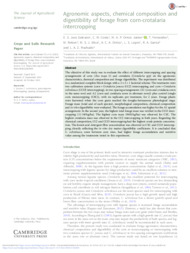Agronomic aspects, chemical composition and digestibility of forage from corn-crotalaria intercropping.
Agronomic aspects, chemical composition and digestibility of forage from corn-crotalaria intercropping.
Author(s): JARA GALEANO, E. S.; COSTA, C. M.; ORRICO JUNIOR, M. A. P.; FERNANDES, T.; RETORE, M.; SILVA, M. S. J.; ORRICO, A. C. A.; LOPES, L. S.; GARCIA, R. A.; MACHADO, L. A. Z.
Summary: The objective of this study was to evaluate the effect of different intercropping and spacing arrangements of corn (Zea mays L) and crotalaria (Crotalaria spp) on the agronomic characteristics, chemical composition and forage digestibility. The experiment was distributed in a randomized complete block design with a 2 × 2 + 1 factorial scheme. The treatments were two cultivation systems (corn + Crotalaria juncea (CCJ) intercropping, and corn + Crotalaria ochroleuca (CCO) intercropping), in two spacing arrangements (A1 (corn and crotalaria sown in the same row) and A2 (corn and crotalaria sown in alternate rows)) plus control (single corn monocropping (CSC)), with six replicates per treatment, for 2 years. Forage plants were harvested when the corn grain reached the doughy-farinaceous phenological stage. Forage mass (total and of each species), morphological composition, chemical composition and in vitro digestibility were evaluated. The forage accumulation was higher for the A1 spatial arrangement. In the second year, the highest total forage mass was verified in the CCO inter- cropping (11 140 kg/ha). The highest corn mass (9402 kg/ha) was observed for CSC. The highest crotalaria mass was observed in the CCJ intercropping in both years. Regarding the chemical composition, CCJ and CCO intercropping had the highest crude protein concentra- tion. The lowest acid detergent fibre concentration was observed in CSC and CCO intercrop- ping, directly reflecting the in vitro dry matter digestibility coefficients. It is concluded that C. ochroleuca, sown between corn rows, had higher forage accumulation and nutritive value among the treatments tested in this experiment.
Publication year: 2021
Types of publication: Journal article
Keywords: Cultivo consorciado
Observation
Some of Embrapa's publications are published as ePub files. To read them, use or download one of the following free software options to your computer or mobile device. Android: Google Play Books; IOS: iBooks; Windows and Linux: Calibre.
Access other publications
Access the Agricultural Research Database (BDPA) to consult Embrapa's full library collection and records.
Visit Embrapa Bookstore to purchase books and other publications sold by Embrapa.

